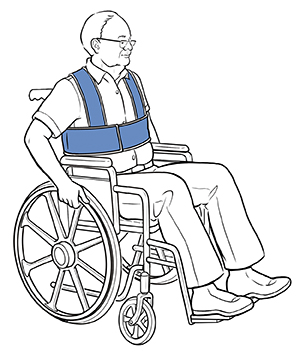Loss of Trunk Control: Safety Tips
Trunk control is your ability to control your upper body (your trunk or torso). It affects how well you can hold your body upright when sitting or moving. Loss of part or all of your trunk control can happen after a stroke, brain injury, or spinal cord injury. It can also be caused by some neurological conditions, such as Parkinson disease or multiple sclerosis. Alcohol abuse or long-term use of some medicines can also affect your trunk control. Loss of trunk control can make falls and injuries more likely.
Trunk control is important for balance
Normally, your nerves and muscles let you sense where your body is and how it’s moving. This helps with balance. Damage to the normal nerve and muscle function in your trunk can make this more difficult. Weak trunk muscles can also make it hard to keep your body upright and stable. If you have these problems, you’re more likely to have trouble staying balanced. You’re also more likely to have trouble catching yourself and preventing falls if you do lose your balance.
Improving positioning
 |
| Your healthcare provider can recommend supportive devices and equipment to help you move around safely. |
Correct positioning is key to keeping your balance and preventing injury. For safe positioning, follow these tips:
-
When sitting, have correct support. Sit on a chair with a firm seat, back, and armrests. Sit with your thighs parallel to the floor and keep your feet flat on the ground. If you’re in a wheelchair, you may need to have it adjusted for correct support. Your healthcare provider can advise you on the best way to do this.
-
Don't slump or lean. If needed, your provider can advise back supports, chest straps, or other supportive devices to help hold you upright. You’ll be taught how to use these devices safely.
-
Check your posture often. Make sure that you are not slumping or leaning to one side. One way to do this is by looking at yourself in a mirror and adjusting your body position as needed.
-
Don’t rely only on your strong side . If you have been given exercises, be sure to do those to help strengthen your weaker side. Having one side much weaker than the other increases your risk of falls.
Changing positions safely
Falls are most likely to happen when you’re changing positions. This includes reaching, turning, bending, standing up, and starting to walk. These tips can help you move more safely:
-
Always keep your mobility aids with you. These are types of equipment that may be prescribed to help you get around. They include walkers, canes, crutches, and wheelchairs. Use them as directed by your healthcare provider.
-
Look before you move. Check for any dangers around you, such as objects on the floor. And look down at yourself to see how your torso, arms, and legs are placed.
-
Don’t move too quickly. Even if you are sitting safely, a simple movement, such as reaching for an object, could be harmful. It could make you lose your balance and fall. So move slowly and carefully. Also, get close to anything you want to pick up. Keep objects that you use all the time within easy reach.
-
Be sure all your rooms have enough light. This helps you see where you are and where you’re going. It also helps you see things that might be in your way.
-
Seek out stable support. Be extra careful when you grab or lean on tables, counters, or other objects for support.
-
Know your limits. If you can’t make a movement safely, ask for help.
Working with your therapist
A physical or occupational therapist will work with you to develop skills for better trunk control. You’ll learn ways to improve your sense of balance, body position, and movement. Mirrors and other tools may be used to help with this goal. You’ll also learn exercises for better muscle strength. Follow all directions from your therapist about how and when to do these exercises.
Getting help if you fall
You can take steps in advance to get help in case a fall occurs. This may include the following:
-
Keep a list of emergency numbers near the phone.
-
Always have a way to call for help.
-
Keep a cell phone with you at all times. Or talk with your healthcare provider about how to set up a home monitoring service. This means wearing a small device around your neck on a chain. If you fall, you can press the button on the device. This alerts emergency responders to come and help you.